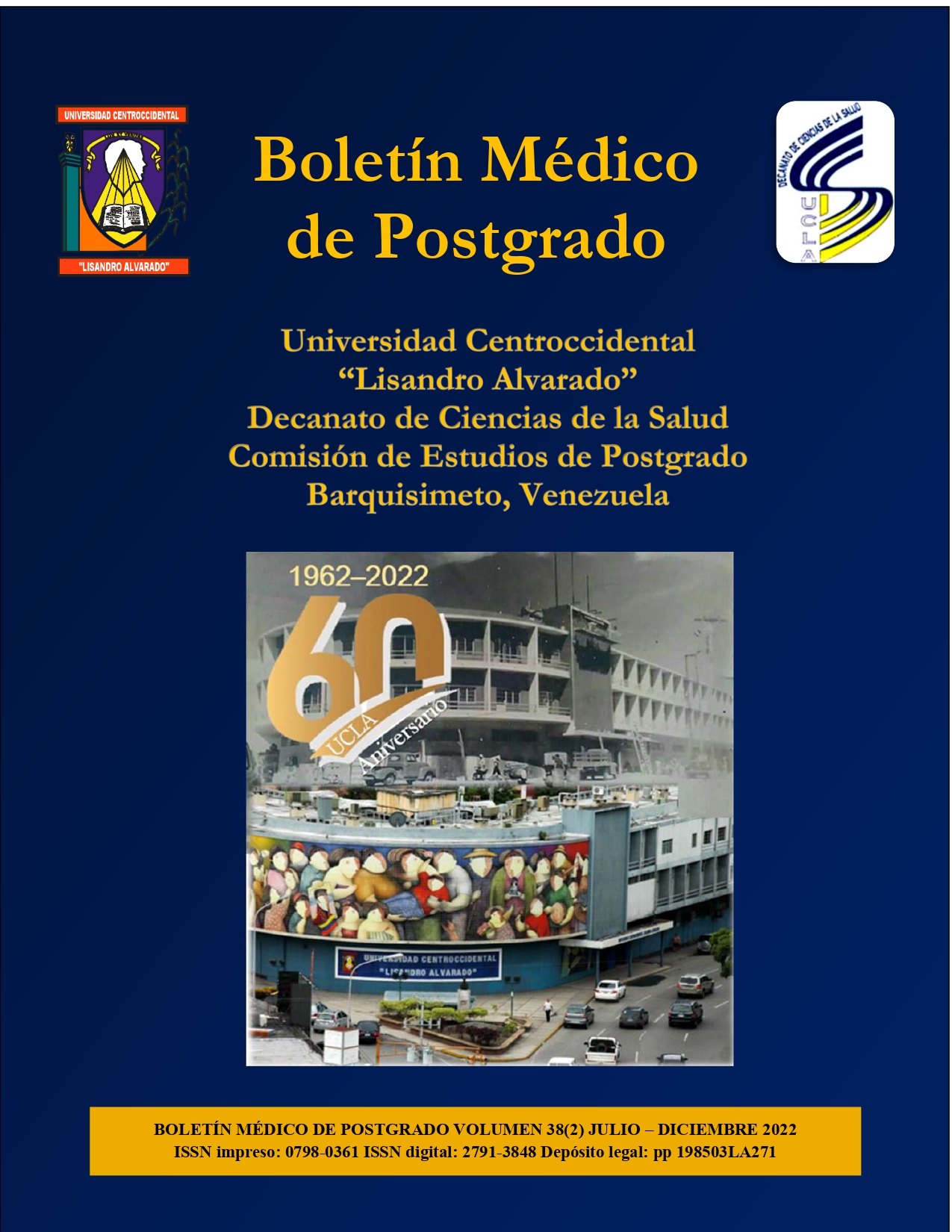Characterization of functional capacity of patients with a history of scasest after a cardiovascular rehabilitation program
Keywords:
acute coronary syndrome, mortality, cardiac rehabilitation, myocardial ischemia, myocardial revascularizationAbstract
Ischemic heart disease represents the leading cause of death worldwide and Venezuela does not escape this reality. Most studies reveal a beneficial effect of cardiac rehabilitation in patients with ST elevation (STEACS) however there is little evidence in patients with non-ST elevation acute coronary syndrome (NSTEACS). This study was an observational, descriptive and retrospective design aiming to characterize the functional capacity of patients with a history of NSTEACS after the cardiovascular rehabilitation program. 55 patients with a history of NSTEACS who were admitted to the secondary prevention unit of the Centro Occidental Regional Cardiovascular Center, in the period January 2017-2020 were included. The associated pathologies in these patients were arterial hypertension (67.2%), diabetes mellitus (25.4%), overweight or obesity (14.5%), kidney disease (10.9%); the proportion of smokers and with sedentary lifestyle was 24.4% and 20%, respectively. The patients were receiving medical treatment with ACEI (30.9%), ARA II (40%), beta-blockers (90.9%), ASA (65.4%), clopidogrel (1,8%), DTAP (29%) and statins (94.5%). Patients with NSTEACS who entered the cardiac rehabilitation plan at 2 months were mostly in functional class I (94.5%). There was only one case of worsening functional class in the group of non-revascularized patients, associated with worsening angina.
Downloads
References
Las 10 principales causas de defunción [Internet]. Who.int. Disponible en: https://www.who.int/es/news-room/fact-sheets/detail/the-top-10-causes-of-death
República Bolivariana de Venezuela. Anuario de Mortalidad 2014. Ovsalud.org. Disponible en: https://www.ovsalud.org/wp-content/uploads/Anuario-Mortalidad-2014.pdf
The Framingham Disability Study. Relationship of Various Coronary Heart Disease Manifestations to Disability in Older Persons Living in the Community. Am J Public Health 1990; 80(11): 1363–1367.
Kriskovich Jure J. Rehabilitación en el enfermo coronario. Rev CONAREC 2003; 69(19): 42-50.
Smith SC, Benjamin E, Bonow R, Braun L, Creager M, Franklin B, et al. AHA/ACCF Secondary Prevention and Risk Reduction Therapy for Patients with Coronary and Other Atherosclerotic Vascular Disease: 2011 Update. A Guideline from the American Heart Association and American College of Cardiology Foundation. Circulation: Clinical Summaries 2011; 124: 2458.
Chamorro C, Guidi D, Yáñez F, Chamorro G. Factores determinantes de éxito de la rehabilitación cardiovascular en pacientes coronarios sometidos a revascularización miocárdica. Rev Chil Cardiol 2017; 36: 185–193.
Campos N. Evaluación funcional de un programa de rehabilitación cardiovascular en pacientes después del intervencionismo coronario percutáneo. Rev Cuba Cardiol Cir Cardiovasc 2018; 1561-2937.
Sunamura M, Ter Hoeve N, van der Berg-Emons R, Boersma E, van Domburg R, Geleijnse M. Cardiac rehabilitation in patients with acute coronary syndrome with primary percutaneous coronary intervention is associated with improved 10-year survival. Eur Heart J Qual Car Clin Outcomes 2018; 4(3): 168-172.
Gómez M. Efecto de la rehabilitación cardiaca en pacientes isquémicos no sometidos a revascularización coronaria. Arch inst cardiol mex 2000; 70: 552-560.
Kentala E. Physical fitness and feasibility of physical rehabilitation after myocardial infarction in men of working age. Annals Clin Res 1972; 9: 1-84.
Oldridge NB, Guyatt GH, Fischer ME, Rimm AA. Cardiac rehabilitation after myocardial infarction. Combined experience of randomized clinical trials. JAMA 1988; 260(7): 945-950.
O'Connor G, Buring J, Yusuf S, Goldhaber S, Olmstead E, Paffenbarger R, et al. An overview of randomized trials of rehabilitation with exercise after myocardial infarction. Circulation 1989; 80(2):234-44.
Maroto Montero JM, Artigao Ramírez R, Morales Durán MD, De Pablo Zarzosa C, Abraira V. Rehabilitación cardíaca en pacientes con infarto de miocardio. Resultados tras 10 años de seguimiento. Rev Esp Cardiol 2005; 50(10).
Grima-Serrano A, García-Porrero E, Luengo-Fernández E, León Latre M. Cardiología preventiva y rehabilitación cardiaca. Rev Esp Cardiol 2011; 64(1): 66-72.
Rivas E. El ejercicio físico en la prevención y la rehabilitación cardiovascular. Rev Esp Cardiol 2011; 11(5):18–22.
Pérez Yánez LM, Gutiérrez López A, Rodríguez Blanco S, Leyva Quert AY, Rogés Machado RE. Rehabilitación cardiovascular post intervencionismo coronario percutáneo. Rev Cuba Cardiol Cir Cardiovasc 2018; 24(1): 35-50.
Published
How to Cite
Issue
Section

This work is licensed under a Creative Commons Attribution-NonCommercial-ShareAlike 4.0 International License.
Las opiniones expresadas por los autores no necesariamente reflejan la postura del editor de la publicación ni de la UCLA. Se autoriza la reproducción total o parcial de los textos aquí publicados, siempre y cuando se cite la fuente completa y la dirección electrónica de esta revista. Los autores(as) tienen el derecho de utilizar sus artículos para cualquier propósito siempre y cuando se realice sin fines de lucro. Los autores(as) pueden publicar en internet o cualquier otro medio la versión final aprobada de su trabajo, luego que esta ha sido publicada en esta revista.



